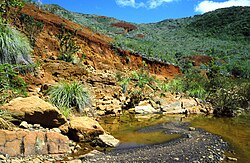Nickel mining in New Caledonia

A creek in southern New Caledonia. Red colours reveal the richness of the ground in nickel and iron oxides
|
|
| Location | |
|---|---|
| Location | subregion of Melanesia in the southwest Pacific. |
| Overseas territory of France | |
| Country | Melanesia |
| Production | |
| Products | Nickel |
| Production | 107,000 tonnes in 2009 |
| History | |
| Opened | 1864 |
Nickel mining in New Caledonia is a major sector of the New Caledonian economy. The islands contain about 7,100,000 tonnes of nickel which is about 10% of the world's nickel reserves. With the annual production of about 107,000 tonnes in 2009, New Caledonia was the world's fifth largest producer after Russia (266,000), Indonesia (189,000), Canada (181,000) and Australia (167,000). Nickel production in New Caledonia accounts for 7–10% the country’s GDP and is responsible for as much as 80% towards foreign earnings. With the exclusion of tourism, nickel ore and derived metallurgical products represent about 97% of the total value of exports.
New Caledonia has the longest history of mining in the Pacific islands. Nickel was found in New Caledonia in 1864 by the engineer Jules Garnier. It was distributed in the ore layers which cover about one third of the area of the main island of New Caledonia. The nickel concentration was inhomogeneous and also varied with the depth. Whereas its usual concentration was 2–5 percent, it could reach 10–15 percent in scattered deposits of green garnierite. Those areas were developed first using primitive manual extraction methods and were gradually depleted, resulting in the present average concentration of about 2.6 percent. This nickel is located at the depth of about 30 metres (98 ft). Shallower layers of 10–20 metres (33–66 ft) also contain nickel, but at half of the concentration. They remain unexploited and constitute most of the nickel reserves of New Caledonia.
Wide-scale mining started in 1875 in Houaïlou and Canala communes. Early mining was done by hand and then gradually became mechanised. By beginning of the 20th century two large mines at Bourai and Thio were established. In the initial years, after nickel was discovered mining was done in about 330 mines. However, in 1981 there were only 30 functional mines as against 130 in the early 1970s. Because of the remote location of the islands, about half of the ore was smelted locally, despite the underdeveloped industrial infrastructure of New Caledonia. Another half was exported, mainly to Japan. The first nickel smelter was built in 1879 with two other added in 1910 and 1913. The smelted product contained about 70–80% nickel and was sent for refining to France. Because of low nickel content in the ore, local smelting resulted in vast amount of displaced rocks near the smelters that changed the local landscape.
...
Wikipedia
